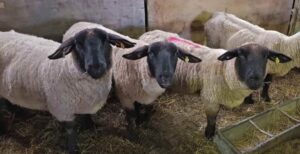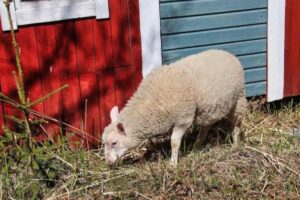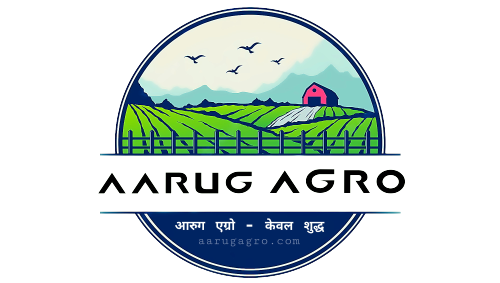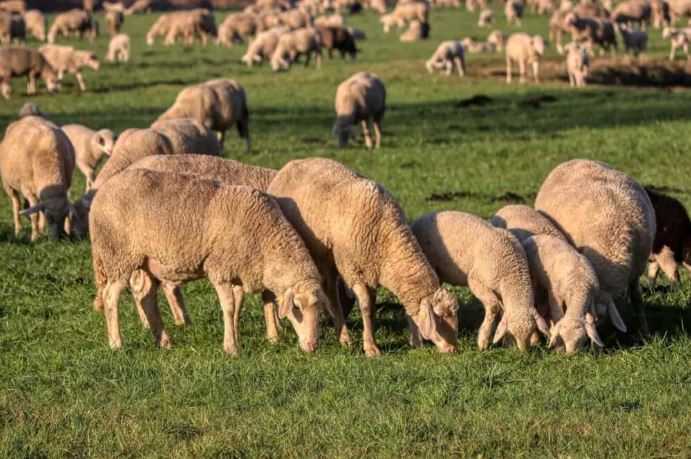Sheep Farming in Kenya: Sheep are raised on open fields using the agricultural practice of sheep farming. To remove their wool, the animals are sheared once a year while being maintained in groups. In addition to these activities, a farm may also produce milk and raise and sell lamb or mutton.

Kenyan sheep farmers employ a variety of techniques to maintain the wellbeing of their flocks. They are fed hay, corn, and other fresh meals; given water; kept warm by utilizing firewood or electric fences to prevent them from wandering too far from the farm buildings.
Sheep farming in Kenya
Is Kenyan sheep farming profitable?
- Sheep farming has a long history in the nation, and the business is still expanding today. Many Kenyans rely on sheep farming as a major source of income, and it is crucial to the nation’s economy.
- You can raise sheep on a small-scale or a large-scale if you have the right facilities. Commercial sheep farming is incredibly lucrative, and you will soon recover your investment.
- The breed of sheep you grow, the environment where you live, and the market conditions all affect how profitable sheep farming is in Kenya.
- If you grow Merino wool sheep, you can make a lot of money from sheep farming in Kenya. Additionally, they are perfect for farmers in places with a variety of temperatures because they can adapt well to them.
- If you raise different breeds of sheep, your profits might not be as large. Additionally, sheep farming entails a high level of risk, thus it is critical to have strong estimating and planning abilities before starting out in this industry. Overall, while Kenyan sheep farming may have the potential to be profitable depending on the particular elements involved, it is always advisable to seek the advice of an experienced specialist before making any decisions.
Zero grazing sheep farming in Kenya
In Kenya, a novel and distinctive kind of sheep husbandry called zero-grazing has grown in popularity in recent years. In order to prevent sheep from using grasslands as pasture, zero-grazing sheep husbandry involves constantly moving the animals. Additionally, because it does not rely on artificial feed additives or fencing, this approach is more environmentally friendly than regular grazing.
In Kenya, zero-grazing sheep farming has several advantages, including better soil quality, increased output, and lower greenhouse gas emissions. In comparison to conventional grazing systems, this style of farming is said to be simpler and less expensive to administer.

Sheep farming for beginners in Kenya
- Kenyan farmers can greatly enhance their standard of living by engaging in sheep farming. Lamb, which can be sold fresh or frozen, is the primary livestock product produced by sheep farming. Sheep are beneficial for producing wool as well, and their dung can be used to fertilize crops. In Kenya, feeding sheep is a crucial aspect of sheep farming. To keep healthy, sheep must consume a lot of hay, fresh produce, and other dietary supplements. Sheep are typically fed twice daily by farmers—in the morning and in the evening.
- In Kenya, sheep farmers typically provide their flocks hay, fresh produce, and other dietary supplements. The most crucial element in raising sheep is hay since it keeps the animals fed and healthy. Because they aid in the sheep’s acquisition of sufficient amounts of vitamins and minerals, fresh vegetables are also crucial to their wellbeing. To ensure that their sheep receive the necessary nutrients, farmers typically give them a variety of vegetables.
- You will want a government permit if you want to start sheep farming in Kenya. You must buy a ram and several ewes (female lambs) once you obtain your permission. Additionally, you will need to build a shelter for the sheep and purchase some hay and feed.
- It is time to begin once you have obtained all the required tools. To begin with, split the grass into manageable sections and assign each lamb a particular area. After that, give the rams hay every day to keep them fed and healthy.
- It is time to breed the rams once they are mature. You must first transport them to a nearby farm to be castrated (sterilized). You will then bring them back to your farm so they can continue to produce lambs there.
Feeding management for sheep farming in Kenya
The managed grazing of sheep is the foundation of Kenya’s prosperous and sustainable sheep farming sector. To give the animals the nutrition they need while grazing, hay, straw, and other plants are fed to them. In order to complement their diet and provide a healthy habitat for the animals, the farmers also grow crops close to their flock. Feeding your sheep is a crucial component of maintaining their health and wellbeing. Take into account the following advice when feeding your flock:
- Determine how much hay your sheep will require daily first. This will depend on their dimensions, weight, and the outside temperature. Utilizing a hay weighing scale or measuring tape, you can compute this.
- Then, make sure there is enough fresh water available for them to drink. A gallon of water per day is about what sheep require. Provide additional water sources, such as rain barrels or cisterns, if you are in a dry area.
- Additionally, you ought to give your sheep a healthy diet that includes hay, fruit and vegetables that are still in season, salt, and other minerals. A balanced feed for sheep should contain 50% hay, 35% fresh produce, and 15% minerals. For particular feeding advice, contact the regional agricultural extension office in your area.
- Last but not least, take caution when loading your sheep onto trailers or trucks to move them to a pasture or a wool shed. Make sure they are weighed accurately initially to prevent overloading.
Kenyan sheep farming operations
Kenya has a large number of sheep farms, however the majority are in the country’s central and eastern areas. The relative quantity of grass and water in these locations, as well as the fact that there is a high population density, are the main causes of this. Kenya experiences year-round rainfall and a relatively temperate climate.

The two rainy seasons are, however, from late December to early January and from mid-July to mid-August. Due to the vast range of elevations at which sheep can be raised, there are many different types of sheep farming in Kenya. Additionally, Kenya is home to a variety of sheep breeds.
Kenyan sheep farming on a small scale
In Kenya, small-scale sheep farming is a common form of agriculture. This is due to a number of factors. First off, sheep thrive in Kenya’s climatic circumstances. Second, Kenya has a sizable prospective market for wool and lamb. Finally, using conventional techniques, small-scale farmers may simply manage flocks and maximize production. In Kenya, there are numerous options to launch a small-scale sheep farm.
The most typical strategy is to buy an existing farm. As an alternative, you can rent land from a sheep farmer. Finally, leasing some property to a shepherd will allow you to start your own farm. Planning is essential for the environmentally sensitive activity of sheep farming. You must take your farm’s location, accessible soil types, and weather conditions into account.
Additionally, you will need to construct barns and fences, set up water storage facilities and animal shelters, and grow food to feed your cattle. Be prepared to spend time and money if you want to start a small-scale sheep farm in Kenya. The ability to generate fresh food products that are necessary for the local population makes this sort of agriculture satisfying.
sheep farming for profit in Kenya
Sheep farming on a large scale contributes significantly to Kenya’s export revenue and economy. The business has been expanding consistently, helped by rising income levels and growing consumer demand for products made of wool. Because wool has a high value, commercial sheep farming is a high-value product. Sheep also produce milk, which is important for making cheese. In Kenya, lamb is also a well-liked meat product.
In Kenya, sheep farming is practiced extensively. An average of 50 to 500 sheep are raised on per hectare. There are around 200 animals in a flock. During the winter, sheep are given hay, new, green grass, and corn mash. In the summer, they receive hay, grain, and salt licks. under order to prevent the sheep from damaging crops or other property, shepherds use fences to keep the flock under check.

Business ideas for raising sheep in Kenya
In Kenya, there are numerous sheep farming operations, but picking the best one is crucial. Here are some pointers to get you going:
1.Get a good land lease: Finding appropriate land to lease is the most crucial component of launching a sheep farming business. Make sure there are ample freshwater sources and that the land is properly drained. Additionally, you will need to bargain with the landlord for a solid lease.
2. Get started early: Your chances of success are higher the earlier you begin your sheep farming business. Before investing in this business, make sure you thoroughly plan your investment and have all the essential tools.
3. Choose a breed of sheep that best suits your climate and location: Sheep come in a variety of breeds, each with its own special qualities and attributes. Take into account the region’s climate as well as the soil and plant life that can be found there. Select a breed that can thrive in your environment.
Sheep farming areas in Kenya
On the equator in Eastern Africa is a country called Kenya. With a population of almost 47 million, it has a total area of 193,912 square kilometers. Kenya has a humid tropical climate with four distinct seasons: the wet season, the dry season, the monsoon season, and the winter. Western, Central, and Eastern are the three primary geographical regions in Kenya.
- The Lamu and Mombasa coastline counties, which border Somalia, make up the Western area.
- The Rift Valley province, which includes the significant towns of Kisumu and Eldoret, and Nyanza province, which includes Nairobi as its capital, are both located in the Central area.
- The coastal areas in the eastern part of Kenya include Lamu, Mombasa, Diani Beach, the Tana River District (which includes Wajir County), Garissa County (which includes Garissa Town), Turkana County (which includes Borana Town), Nakuru County, and Kitui County (which includes Kitui Town).
The main sheep farming regions in Kenya are Lamu Island, where there are lots of rangelands for both sheep and goats, Isiolo, where there are large expanses of agricultural land suitable for growing sheep and other crops, and Nyanza Province.
Districts like Machakos, Kiambu, Bungoma, and Migori, as well as the Embu Hills, in the Eastern Province, have good wetland grazing potential. The Dorper sheep breed, however, is assuming pride of place on farms thanks to its resistance to the whims of climate change from Narok to Kajiado, Makueni, Machakos, and sections of the dry northern Kenyan rangelands where sheep herding is predominant.
Benefits of sheep farming in Kenya
Sheep farming in Kenya has several advantages, including a high rate of production and a large range of goods. Sheep are productive farmers that graze rapidly and yield large quantities of milk, meat, and wool. They are the best option for both rural and urban locations because they are resistant to several pests and diseases.

Sheep breeds in Kenya
Kenyan sheep husbandry is classified into dry land and wetland farming. Wetland sheep farming takes place in marshy or riverine environments, while dry-land sheep farming takes place on broad plains. Merino, Corriedale, Southdown, Hampshire down, Romney marsh, Dorper, Red Masai, and Somali sheep are the primary sheep breeds in Kenya. Sheep can be broadly divided into four categories: mutton, wool, dairy, and dual purpose, such as mutton and wool or mutton and milk.
1.Dorper, Persian Black Head, Red Masai, and their hybrids with indigenous stock are some of the hair sheep breeds.
2.Merino, Corriedale, Romney Marsh, and hybrids of these breeds with indigenous stock are wool and dual-purpose breeds.
Kenyan sheep farming issues
1.In Kenya, sheep farming is a significant industry that provides farmers’ families with food and revenue. But there are a number of issues with sheep farming in Kenya that need to be resolved.
2.Overgrazing, competition from other livestock businesses, disease and parasite outbreaks, and a shortage of water are a few of Kenya’s most frequent sheep farming issues. Due to erosion, desertification, and the loss of key grasslands, overgrazing is a significant issue in Kenyan sheep farming. As a result, the number of sheep in the flock may decrease, wool output may decrease, and the sheep may become more susceptible to parasites and disease.
3. A significant obstacle for Kenyan sheep producers is competition from other livestock businesses. The competition for grazing pasture between dairy cattle, pig farms, poultry farms, and goat herds lowers sheep farmers’ yields. These other sectors also produce a significant amount of pollutants that are harmful to both human and sheep health.
4. In Kenyan sheep farming, disease and parasite outbreaks are also frequent issues. For instance, if Newcastle Disease, a serious viral sickness that damages lambs’ muscles, is not properly treated, it might be fatal. Additionally, parasites like lice can be detrimental to the livelihood of sheep producers.
5.Another significant issue that Kenyan sheep farmers deal with is a lack of access to potable water. Due to drought or pollution, many regions used for sheep farming lack access to dependable water sources.
Sheep farming loans in Kenya
Due to its abundance of pastureland and long tradition of sheep farming, Kenya has several sheep farming loans. Loans for sheep farming can be used to buy land, erect fences and other necessary machinery, as well as pay for initial startup expenditures. Additionally, a lot of lenders provide deferral or temporary interest-free options, making it a desirable investment for individuals wishing to enter the market.
Challenges in sheep farming in Kenya
Sheep farming is a longstanding and large industry in Kenya that makes a considerable economic contribution. The sector does, however, encounter certain difficulties. These include the inability to access land, a lack of water, and pests and illnesses. Additionally, the price of wool and lamb exports has fallen recently due to competition from other animal production industries. But sheep husbandry has long played an important role in Kenyan agriculture.
However, the industry is currently facing difficulties, such as growing competition from other agricultural pursuits and a declining sheep population. High disease frequency, a shortage of available land, and the availability of water are the key obstacles to sheep farming in Kenya. Due to nearby farmed goats and pigs spreading diseases to sheep, there is a significant disease prevalence. Because they compete with pigs and goats for resources, sheep also have parasitic infections and external wounds.

Because Kenyan climates do not support the traditional practice of grazing sheep on long grasses, the shortage of land is a concern. Additionally, water scarcity poses a problem for sheep breeders in several areas of Kenya. Through subsidies and other support programs, the government promotes sheep farming, although these efforts have not been sufficient to overcome the sector’s difficulties. The wellbeing of animals in sheep ranches is another issue. Climate change is also anticipated to have an influence on Kenyan agriculture, notably sheep rearing.
Conclusion
One of Kenya’s oldest and most traditional agricultural methods is raising sheep. In Kenya, sheep farming dominates the agricultural sector and generates about 50% of the GDP. Europe is the biggest market for products made from Kenyan sheep, followed by the US. Farmers in Kenya need good pastureland and access to water in order to successfully rear sheep. In order to operate their machinery, including fences and shearing machines, they also need a dependable electric power source.


